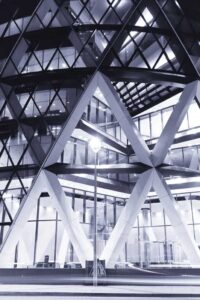
In recent years, the metal architecture industry has undergone transformations. Dynamic shifts included environmental consciousness, technological innovations, and global dynamics. As the list of concerns grows, it is sustainability climbing to the top, resulting in the industry reevaluating its practices, materials, and long-term impacts. Following closely behind is the integration of Artificial Intelligence (AI) and Building Information Modeling (BIM). Digital tools are reshaping the landscape of design and fabrication processes. However, these advancements come with their own set of challenges, particularly in adapting to ever-evolving regulations, codes, and standards. The industry is navigating the always-evolving world of metal architecture, seizing opportunities while overcoming obstacles. Here is what the experts have to say.
How has the metal architecture industry evolved in the past few years, and what key trends are currently shaping its trajectory?

Alan Scott: Regulatory requirements and voluntary initiatives related to sustainability are shaping the metal architecture industry, including efforts to reduce embodied carbon in building materials, increased focus on energy efficiency and operational carbon emission reduction, and climate and natural hazard resilience.
Renee Ramey: The Metal Roofing Association (MRA) believes homeowners are getting more comfortable with metal as a solution for roofing. This is based largely on increasing awareness regarding the benefits that metal can provide; longevity, durability, and performance. Consumer focus on lowering environmental impacts by using recycled products and products that can be recycled is growing in importance. Building with products that are less impactful to our environment, easier to maintain, last longer, and provide beauty, that is where we see the residential roofing market headed.

Robert Tiffin: The most significant evolvement came with the publishing of Chapter 19 of the 2024 edition of the International Building Code (IBC) as it provides a clear explanation of what constitutes a metal building system.
“METAL BUILDING SYSTEM. An integrated set of fabricated components and assemblies that form a complete or partial building shell that is designed by the manufacturer. This system typically includes but is not limited to primary framing comprised of built-up structural steel members, secondary members that are cold-formed steel or open-web steel joists, a metal panel roof system and exterior wall cladding. The system is manufactured in a manner that permits plant and/or field inspection prior to assembly or erection.”

A trend that is rapidly developing is the industry collaborative effort (Metal Building Manufacturers Association [MBMA]/Metal Building Contractors and Erectors Association [MBCEA]) for market expansion. We have the research, the resources, the tools, and the realities that metal building systems are safe, cost-effective construction solutions.
A second significant trend is the MBCEA, Metal Building Institute (MBI), and National Center for Construction Education and Research (NCCER) are collaborating on a groundbreaking initiative to develop a comprehensive Metal Building Assembly Training program. This program aims to reach the level of a formal apprenticeship, providing in-depth training in the specialized requirements of metal buildings. Each module will prioritize safety and building integrity. Departing from traditional methods, the program will be delivered through a modern online format, eschewing reliance on textbooks and outdated learning approaches.

Sophie Hong: There is an endless array of possibilities with metals—from the way it is shaped, stamped, welded, or casted. Its structural properties allow it to contribute strength and aesthetics at the same time. Our craft for working with metal has become cleaner and crisper. We thrive in the challenge of creating something beautiful from components that might not be so glamorous. Simple materials like the corrugated metal we are using on the Parrott Creek project provide a perfect bridge between agricultural and modern residential. The use of rugged metal finishes has become more accepted for refined uses as well. With the rise of building costs and durability of the material, it is becoming an ever-easier decision for us to choose metal. It is important for us to be economical and purposeful about our material choice. Durability and ease of maintenance were key factors driving our decision to employ metal standing seam roof and corrugated metal siding at Parrott Creek.
With sustainability becoming a growing concern, how is your industry addressing environmental considerations in terms of materials, construction processes, and long-term impact?
Scott: The metal architecture industry is recognizing a collective need to address the greenhouse gas emissions (GHG) and other environmental impacts from manufacturing materials, and the GHG emissions from the operation of buildings. The solutions include efficiency improvements and investment in renewable energy sources for manufacturing, improvements in high-performance building design, and resource efficient construction innovation such as modular construction. An emerging trend includes potential use of renewable hydrogen in metals manufacturing, and an evolution toward a circular economy with closed-loop recycling of metal materials.
Ramey: Metal roofing already outshines other roofing materials in areas of sustainability. Metal roofing’s durability and longevity have been proven time and time again in the most difficult areas where severe weather events and rigorous environmental demands exist. Further, it is ability to lower heating and cooling costs, be recycled at end-of-life, and easy maintenance make metal roofing stand-out as the superior option when it comes to sustainability.
Tiffin: The metal building systems industry has long promoted its sustainability of practices and products, with Life Cycle Analysis (LCA) and Environmental Product Declarations (EPDs) (respectively by manufacturer, or MBMA). Strong efforts and attention are being paid to components and their cradle to grave, or cradle to cradle contribution to the overall building environmental impact.
Hong: The most sustainable building is the one that never gets torn down. Since steel has almost an eternal lifespan, designing properly with steel and accounting for future factors our buildings would last for a long time—at the very least, the core structure would remain while the finishes evolve around it.
On our construction site at Parrott Creek there were buildings more than 50 years old and literally crumbling, so we decided to remove all existing buildings that were broken down and sorted to be delivered to the proper channels for recycling. We are thinking about the lifecycle of a building as cradle to cradle, doing what we can to recycle or reuse old building material. At Parrott Creek we are employing steel to express a floating building over a hillside—something we would not be able to do without it. But our use of steel use is limited because of location access and a desire to limit the number of different trades on site. As a solution we landed on specifying steel that a framer could install with limited welding. We expanded the footprint to create a much-needed area for youth living rooms on a complicated, uneven site. By floating the building the youth get to experience nature from the inside, feeling as if they are nestled within the trees.
In the face of technological advancements, how are digital tools like AI and BIM influencing design, fabrication, and construction processes?
Ramey: These tools are absolutely impacting the marketplace for metal roofing, and for the better. Any hesitation a contractor may have to installing metal roofs melts away when they realize the many tools available to make the process easier, more efficient, and more profitable. From modeling capabilities and tooling to design and estimating software, the ability of individuals and/or companies to offer industry-leading products and services is easier than ever.
Tiffin: Paraphrasing the BIM/FAQ,1 in the metal building industry, the same entity/manufacturer typically handles their respective structural design, drafting, and fabrication, often using proprietary software. This may challenge the process driven needs of a BIM program, so we advise companies to work with their manufacturer before leveraging a BIM contract.
AI enables us to expand or rewrite our imaginations as to how we integrate information, analyze data, and use the resulting insights to improve decision-making. Tie in process automation, deep learning, decision management, and emphasizing “safety,” and AI is changing our metal buildings systems forever.
A scalable example of deep learning is with project estimating (aka budgeting or costing). AI-empowered management software, powered with historical data excels in running “what if” scenarios and contingency planning, transforming unexpected situations into anticipated and planned events. The advantage of these “what ifs” scale very quickly with larger and more complex projects.
Hong: Ideally, we always try to generate multiple iterations of a design to arrive at the perfect detail. For example, working on metal cladding, we can use digital tools to set exactly where the corrugations line up with windows and doors. Our intent is to have these panels pre-cut so each end is factory finished. Our next big challenge will be to find the right metal panel shape for our rounded roof corner that hips up into a point. We will be using our 3D modeling skills to determine the size and shape of each panel. We are proposing standing-seam metal roofs for durability, and also because we can clip our solar panels to them easily.
What challenges and opportunities does the metal architecture industry face in terms of adapting to changing regulations, codes, and standards, and how are professionals navigating these complexities?
Scott: The increasing stringency of energy codes will continue to require architects and contractors to consider energy performance in design, detailing, specification, and installation of high-efficiency components and assemblies. In support of this, manufacturers will also need to continue product innovations to boost efficiency. Additionally, federal, state, and local “buy clean” mandates are putting greater emphasis on embodied carbon reduction in materials. Finally, in response to the greater acuteness and regularity of natural hazard events due to climate change, the building industry will be seeing new standards for resilient building materials and assemblies, including roofing, cladding, and glazing systems resistant to high winds, flooding, and wildfire.
Ramey: One of the biggest challenges for metal roofing is dispelling the myths about our products, both aesthetically and performance based. Many times, regulatory bodies such as Homeowners Associations (HOAs), are unaware of metal’s ability to look like any other roofing product on the market or that quality metal roofing products are designed to provide superior performance in any region. The opportunity is great as our industry has done much of the heavy lifting already through rigorous performance testing to support quality metal roofing’s claims. Now we need to share… to drive awareness of the data, to share the facts, and to highlight the beauty and performance that only metal roofing can provide.
Tiffin: One of the more significant challenges ahead is the evolving International Code Council (ICC) code C406.9, Reduced Air Infiltration. The present measured air-leakage rate of the building envelope shall not exceed 0.25 cfm/sf (2.0 L/s x m2), and this is code in those states which have adopted 2018 International Energy Conservation Code (IECC) or greater.
A metal building system can present some logistical challenges to performing an air infiltration test. Three industry associations MBMA, the North American Insulation Manufacturers Association (NAIMA), and the Door & Access Systems Manufacturers Association (DASMA) sponsored a task group which has demonstrated in a number of climate zones that a metal building system performed well in whole-building air leakage testing. The task group continued their work to demonstrate why results exceeded expectations and highlighted that performance of these buildings can reach any level likely to be specified by code or high-performance building standards through implementation of best practices, in a guide and video.
How is the metal architecture industry responding to international demand, trade dynamics, and the need for standardized practices on a global scale?
Scott: Pending rules by the Securities and Exchange Commission (SEC) and the recently adopted State of California legislation for greenhouse gas (GHG) emission reporting and climate-related financial risk disclosure (Senate Bills 253 and 261) are not the only regulations encouraging U.S. companies to consider GHG emission and climate risk reductions. International frameworks like the Taskforce for Climate-related Financial Disclosure (TCFD) and new regulations like the European Union’s (EU’s) Carbon Border Adjustment Mechanism (CBAM) will push businesses operating internationally to make climate responsiveness part of their competitiveness initiatives.
Tiffin: Metal building system manufacturers are optimizing their supply chains to address challenges related to international trade dynamics. This includes managing logistics, sourcing materials globally, and navigating trade regulations. While maintaining their respective and standardized practices, companies may customize their metal building systems to meet local regulatory requirements, climate conditions, and architectural preferences. This ensures the structures are suitable for diverse international markets.
Hong: One of the greatest things about metal is that it is readily available. In Oregon, there are multiple manufacturers within the state providing similar products, so we know we will be able to find what we need. (And earn LEED/sustainability points for local/regional materials.) We like the resilience of the material for a site that gets abused by the weather and will be well used by the residents—and similar products around the globe are used in similar ways. Metal is easy to access, ship and store, adding to its versatility. Best of all steel supports our mission to create and innovate with custom profiles, because it can be used in unexpected ways


